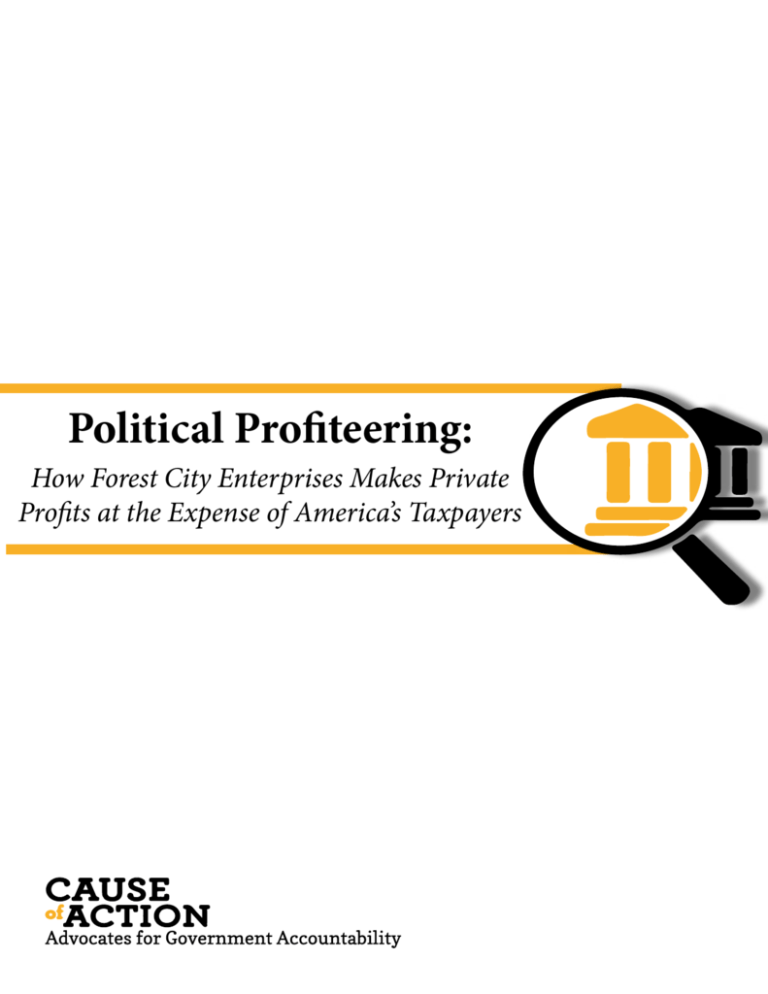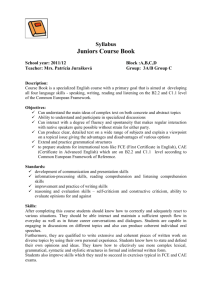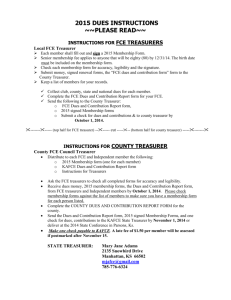Political Profiteering
advertisement

Political Profiteering: How Forest City Enterprises Makes Private Profits at the Expense of America’s Taxpayers Staff Investigative Report Political Profiteering How Forest City Enterprises Makes Private Profits at the Expense of America’s Taxpayers PART I OF III: ANATOMY OF A CRONY CAPITALIST About Cause of Action Mission Cause of Action is a nonprofit, nonpartisan government accountability organization that fights to protect economic opportunity when federal regulations, spending, and cronyism threaten it. Our mission is to expose the ways our government is playing politics in its use of taxpayer dollars, in its decision-making on behalf of individual Americans, and how it seeks to burden the economic opportunities that employ us and make our lives better. Cause of Action seeks to prevent the federal government from politicizing agencies, rules, and spending by bringing transparency to the federal grant and rule-making processes. Cause of Action’s representation of organizations and individuals helps to educate the public about government overreach, waste, and cronyism. Investigative Function Cause of Action uses investigative tools to attack federal government waste, fraud, and mismanagement as well as overreach in the form of arbitrary and burdensome regulations. Cause of Action employs “sunshine advocacy” tools to achieve its goals, including document and information requests, lawsuits, ethics complaints, and requests for investigation. Through its use of advocacy and investigatory tools, Cause of Action promotes transparency, integrity, and accountability in government. Cause of Action’s investigations help expose the ways our government is mismanaging federal funds and educate the public on how government can be made more accountable. Rigorous oversight can prevent taxpayer dollars from being wasted on improper activities. ii Table of Contents Mission........................................................................................................................................ ii Investigative Function ............................................................................................................... ii I. Executive Summary..................................................................................................................... 4 II. Findings ...................................................................................................................................... 5 III. What is Forest City Enterprises?............................................................................................... 5 IV. Politics for Profits ..................................................................................................................... 7 Table 1 ......................................................................................................................................... 7 Figure 1 ....................................................................................................................................... 8 V. Coordinating for Cash ................................................................................................................ 8 VI. Greasing the Wheels in the District of Columbia ..................................................................... 9 Table 2 ....................................................................................................................................... 10 Table 3 ....................................................................................................................................... 11 VII. Conclusion ............................................................................................................................. 11 iii I. Executive Summary When the politically powerful, not the competitive marketplace, determine winners and losers in America’s business decisions, taxpayers take on all of the risk and crony companies extract the profits. The cycle of political profiteering is born when politicians exchange public subsidies for campaign contributions. This method of using the government to profit has become a trademark of one of the largest publicly traded real estate development companies in the United States: Forest City Enterprises. Forest City Enterprises (FCE) is a $10.6 billion company that most Americans have likely never heard of, even though the public finances twenty-three percent of FCE’s revenue. The FCE business model is dependent upon political profiteering: relying on public money and government influence to reap millions in profit. Using highly paid lobbyists, political connections, campaign contributions, and strategic hiring of government officials, FCE obtains lavish public subsidies, tax-exempt financing and the seizure of private land from eminent domain condemnations. The following report exposes the money trail between FCE and its political friends that have resulted in a decade of kickbacks for both FCE and politicians. Between 2002 and 2012, FCE, its subsidiaries, and its employees spent $23 million on campaign contributions and lobbying at the federal, state, and local level. FCE even went so far as to coordinate donations among employees in its project locations: $15.4 million of the $23 million in contributions were made by multiple employees of FCE on the same day. During that same time frame, FCE and its subsidiaries received or signed agreements for fifty-two direct and indirect government subsidies or financial benefits with a total value of at least $2.6 billion. The subsidies amounted to twentythree percent of FCE’s $11.4 billion revenue during that time period. The FCE business model is one that damages competition in the market by abusing market mechanisms in ways that capitalizes off government handouts. This report is Part One of a three-part series examining how Forest City Enterprises uses politics to profit. Preview of subsequent reports: In the reports that follow, resulting from Cause of Action’s nearly two year investigation, CoA will show how FCE took public benefits under the premise of providing jobs for minority workers but failed to deliver as well as how FCE enriched itself through bribery and political graft, without ever being subject to investigation or oversight. 4 II. Findings Finding: Finding: Finding: Finding: Finding: Finding: From 2002 to 2012, FCE and its subsidiaries received or signed agreements for fifty-two direct and indirect subsidies or financial benefits with a total value of at least $2.6 billion. The subsidies amounted to twenty-three percent of FCE’s $11.4 billion in revenues during that time period. FCE, its subsidiaries, and its employees spent $23 million on political spending such as campaign contributions and lobbying at the federal, state, and local level from 2002 to 2012. FCE even went so far as to coordinate donations among employees in FCE project locations: $15.4 million of the contributions were made by multiple employees of FCE on the same day. In key election years, eighty-five percent of FCE’s eighty-one federal political contributions were given to candidates in areas where FCE had real estate projects. Forest City Washington (FCW) in the District of Columbia (D.C.) used campaign contributions to extract favors from the politicians on the D.C. City Council, the D.C. Mayor, and D.C. Delegate Eleanor Holmes Norton for its Yards project. FCW also hired an employee from the Mayor’s office dealing with development to assist in pushing its project. III. What is Forest City Enterprises? Forest City Enterprises was founded in 1920 in Cleveland, Ohio to sell building materials to contractors, but began to focus on real estate development before it went public in 1960 and expanded its operations around the United States.1 It has grown into a company with $10.6 billion in assets with core markets in New York City, Boston, San Francisco, Los Angeles, Washington, D.C., Denver, and Dallas. Forty percent of the tenants at FCE properties around the country are elite corporations and governments, including the City of New York, Millennium Pharmaceuticals, federal agencies such as the General Services Administration (GSA), JP Morgan Chase & Co., and Wellpoint, Inc.2 The company started becoming politically active in the 1970s: Although suburbia remained its prime focus, in the early 1970s, it won a HUD contract to build subsidized housing around the country. That, in turn, put the company in close touch with state housing agencies and city governments. ‘By virtue of that business, we learned how to deal with government,’ says Jim Ratner, who runs Forest City’s commercial group. ‘We understood better than we 1 Forest City Enterprises, Company History, available at http://www.forestcity.net/company/history/Pages/default.aspx, (last visited July 10, 2013). 2 Forest City Enterprises, Supplemental Package Q1 2013, then follow Supplemental Package: Three Months Ended April 30, 2013 and 2012 (Corporate Overview at p. 2; Supplemental Operating Information at pp. 19-20, 30), available at http://ir.forestcity.net/phoenix.zhtml?c=88464&p=irol-reportsother_pf, (last visited July 10, 2013). 5 ever had before how a partnership is created with government that gives them what they want, and gives the company what it wants.’ 3 Its Board of Directors includes a former Congressman who served for 30 years, a 19-year veteran of Fannie Mae, a commissioner chosen by President Obama for the White House Fellows program, and an Obama appointee to the White House Council for Community Solutions.4 Although FCE is not the only real estate development company to receive subsidies for its projects or to use politics to profit, its massive size, with $10.6 billion in assets, ambitious project portfolio, and political connections in core markets make it far and away the most prominent developer to work with local governments on real estate developments around the country. FCE is most well-known, or infamous, for the Atlantic Yards project in Brooklyn, which was overseen by subsidiary Forest City Ratner (FCR) and former FCR CEO Bruce Ratner. The project was dependent upon bringing the New Jersey Nets to Brooklyn and the construction of a new sports arena. The arena, Barclays Center, opened in 2012 after the State of New York used its eminent domain powers to kick private property owners off the land and FCR’s lobbyists accrued numerous financial subsidies and benefits. New York City’s own Independent Budget Office (IBO) reported in 2009 that the arena would be a $40 million net loss for the city over a 30-year period and that the total government benefits to FCR totaled $726 million.5 The housing portion of the project, including a promise for about 2,000 units of affordable housing, has not yet been built despite its original complete date of 2016. Community leaders, like the Committee for Arena Justice, now realize that FCR will not come through with its promise of affordable housing and jobs on the time table that got the company $200 million in direct subsidies.6 The high-profile Atlantic Yards project is just one of many examples of FCE using politics to profit. Cause of Action’s analysis of FCE between 2002-2012 shows that it has built a business model that depends on using political influence to pocket taxpayer dollars. 3 Rob Gurwitt, Deals and Ideals, Governing, November 2007, available at http://www.governing.com/topics/energy-env/Deals-Ideals.html, (last visited July 10, 2013). 4 Forest City Enterprises, Board of Directors, available at http://www.forestcity.net/company/people/Pages/board_of_directors.aspx, (last visited July 10, 2013). 5 David Belkin, Ana Champeny, Michael Jacobs, and George Sweeting, The Proposed Arena at Atlantic Yards: An Analysis of City Fiscal Gains and Losses, New York City Independent Budget Office, Fiscal Brief at p. 1 (September 2009), available at http://www.ibo.nyc.ny.us/iboreports/AtlanticYards091009.pdf, (last visited July 10, 2013). 6 Eliot Brown, When Big Projects Stall, Wall Street Journal, September 7, 2012, available at http://online.wsj.com/article/SB10000872396390443589304577637451747874384.html?mod=googlenews_wsj, (last visited on July 30, 2013). 6 IV. Politics for Profits Finding: Finding: Finding: FCE, its subsidiaries, and its employees spent $23 million on political spending such as campaign contributions and lobbying at the federal, state, and local level from 2002 to 2012. From 2002 to 2012, FCE and its subsidiaries received or signed agreements for fifty-two direct and indirect subsidies or financial benefits with a total value of at least $2.6 billion. The subsidies amounted to twenty-three percent of FCE’s $11.4 billion in revenues during that time period. Cause of Action’s analysis of campaign contributions and lobbying filings at the federal level, nine states, and two cities found that FCE spent $23 million from 2002 to 2012 on politics. During the same ten-year period, FCE and its subsidiaries received or signed agreements for fifty-two direct and indirect government subsidies or financial benefits for its projects with a total value of at least $2.6 billion as shown in Table 1.7 The subsidies amounted to twenty-three percent of FCE’s $11.4 billion in revenues during that time period. Table 1 Year 2002 2003 2004 2005 2006 2007 2008 2009 2010 2011 2012 Totals Assets (in billions) $4.5 $5.0 $7.2 $7.4 $7.8 $9.2 $10.9 $11.7 $11.5 $10.7 $10.7 Political Spending $832,455 $532,507 $1,208,900 $849,273 $8,172,368 $3,245,518 $3,006,650 $1,430,788 $1,671,321 $1,134,812 $1,532,981 $23,617,573 Subsidies $320,100,000 $72,857 $1,223,669 $51,481,176 $960,969 $590,741,117 $315,092,616 $1,335,030,977 $28,607,363 $1,071,000 $1,125,338 $2,645,507,082 Revenues $858,244,000 $739,934,000 $848,121,000 $924,959,000 $1,091,251,000 $1,123,351,000 $1,295,620,000 $1,251,602,000 $1,232,013,000 $1,078,448,000 $1,051,618,000 $11,495,161,000 As illustrated in Figure 1 below, subsidies and revenues are aligned with the left axis and political spending on the right axis. It shows that the major ramp up in political spending preceded the rise of subsidies and higher revenues. Not shown in the chart is that FCE assets more than doubled from $4.5 billion to $10.7 billion between 2002 and 2012. 7 See Table 1. Data collected from Good Jobs First, news reports, cases studies, government agencies, and press releases. Data can be found on our website. Without better transparency from state and local governments on the funding deals, it will remain difficult if not impossible to figure out how much public money developers are getting on these projects. Currently, this number is likely much lower than the actual amount of public assistance FCE has received since 2002. Statistic also includes financial benefits such as the full value of tax-exempt bonds as opposed to only calculating savings on interest. 7 Figure 1 Forest City Enterprises Revenues, Subisides, and Political Spending 2002-2012 $1,400,000,000 $9,000,000 $8,000,000 $1,200,000,000 $7,000,000 $1,000,000,000 $6,000,000 $800,000,000 $5,000,000 $4,000,000 $600,000,000 $3,000,000 $400,000,000 $2,000,000 $200,000,000 $1,000,000 $0 $0 2002 2003 2004 2005 Subsidies 2006 2007 Revenues 2008 2009 2010 2011 2012 Political Spending (right axis) V. Coordinating for Cash Finding: Finding: FCE even went so far as to coordinate donations among employees in FCE project locations: $15.4 million of the contributions were made by multiple employees of FCE on the same day. In key election years, eighty-five percent of FCE’s eighty-one federal political contributions were given to candidates in areas where FCE had real estate projects. Cause of Action analysis of campaign contributions in four states and the District of Columbia show that sixty-seven percent of campaign contributions made between 2002 and 2012 were coordinated so that multiple employees of FCE donated on the same day and often to the same candidate.8 Furthermore, the company’s contributions to members of Congress show a pattern of targeting members that may help their real estate projects. FCE’s political action committee (PAC), Forest City Enterprises, Inc. United for a Sensible Government (FOCUS), first started donating to candidates in 2008, and eighty-five 8 The four states are: California, Maryland, Ohio, and Massachusetts. Out of 903 contributions, 610 were made with more than one contribution going to a candidate on the same day. See also Tables 2 and 3, infra. 8 percent of its contributions have gone to areas where FCE has business interests. Fifteen of the sixteen donations in 2008 went to members of Congress whose districts or states are located where FCE was developing or hoping to develop real estate projects.9 In 2010, thirty-six candidates received donations and at least thirty-two of them were in states or areas where FCE had projects.10 In 2012, at least twenty-two of the twenty-nine donations were in states where FCE had business interests. 11 FCE and its subsidiaries have spent about $5 million lobbying Congress and federal agencies between 2003 and 2012.12 Their lobbying disclosure forms disclose FCE’s business model focused on obtaining federal money for its development projects. Indeed, the first quarter disclosures for 2012 explicitly state that FCE’s purpose is to “Seek federal funding for FCE projects across the United States, in particular Denver, Washington, D.C., Albuquerque, Ohio, New York City and Dallas, TX.”13 VI. Greasing the Wheels in the District of Columbia Finding: Forest City Washington (FCW) in the District of Columbia (D.C.) used campaign contributions to extract favors from the politicians on the D.C. City Council and D.C. Delegate Eleanor Holmes Norton for its Yards project. FCW also hired an employee from the Mayor’s office dealing with development to assist in pushing its project. Forest City Washington (FCW) in the District of Columbia (D.C.) has used campaign contributions to extract favors from the politicians on the D.C. City Council and D.C. Delegate Eleanor Holmes Norton. An investigation by NPR affiliate WAMU 88.5 found that “the D.C. city council has approved more than $1 billion in tax breaks and other subsidies to developers over the past decade. At the same time, these developers donated millions of dollars in campaign cash.”14 FCW donated $34,250 in 2006, more than it had donated in the previous decade, and was handed $145 million in subsidies for two projects in late 2006.15 The subsidies were “meant to revive neighborhoods, and to create jobs and affordable housing. But in some cases, the benefits never materialized, or the subsidies simply weren’t 9 Open Secrets, Forest City Enterprises Contributions to Federal Candidates, available at http://www.opensecrets.org/pacs/pacgot.php?cmte=C00123513&cycle=2008, (last visited July 10, 2013). 10 Open Secrets, Forest City Enterprises Contributions to Federal Candidates, available at http://www.opensecrets.org/pacs/pacgot.php?cmte=C00123513&cycle=2010, (last visited July 24, 2013). 11 Open Secrets, Forest City Enterprises Contributions to Federal Candidates, available at http://www.opensecrets.org/pacs/pacgot.php?cycle=2012&cmte=C00123513, (last visited July 24, 2013). 12 Open Secrets, Forest City Enterprises Annual Lobbying, available at http://www.opensecrets.org/lobby/clientsum.php?id=D000000465&year=2003, (last visited July 10, 2013). 13 Open Secrets, Forest City Enterprises Lobbyist Filing for Q1 2012, available at http://soprweb.senate.gov/index.cfm?event=getFilingDetails&filingID=67BB0DF7-0C8D-4B62-AF59A52519E43115&filingTypeID=51, (last visited July 10, 2013). 14 Julie Patel and Patrick Madden, Deals for Developers, WAMU 88.5, May 20, 2013, available at http://apps.npr.org/deals-for-developers-wamu/, (last visited July 12, 2013). 15 Id. 9 needed.”16 FCW’s Capper Carrollsburg project, which redeveloped an area where 707 public housing units used to stand, was given $55 million in government subsidies. FCW had promised to replace all the public housing units, but has only added half of the 707 after 10 years. The area is mostly covered with “million dollar homes and parking lots for the baseball stadium nearby.”17 The biggest project for FCW was “The Yards” in southeast D.C. It is an $800 million mixed-use project around the home stadium for the Washington Nationals, with land granted to FCW by the General Services Administration after FCE was selected from a competition among other developers. The deal was made possible by the Holmes Norton’s Southeast Federal Center Public/Private Development Act of 2000.18 Along with $90 million in subsidies, FCW also received a $46.1 million HUD insured loan for its luxury housing at Foundry Lofts. The deal created “a risk-sharing program between the District of Columbia Housing Finance Agency and the U.S. Department of Housing and Urban Development.”19 As of July 31, 2013, the rent at these luxury lofts, built with the help of taxpayer dollars, is between $2,100 to $2,500 for a one bedroom and $2,974 and $4,814 for a two bedroom.20 FCE’s campaign contributions, comprised mainly of donations from Ratner family members, reveal donations in bunches to the candidates that can affect their projects. For example, the Ratners in Cleveland rallied around D.C. City Council member Adrian Fenty as their choice for D.C. Mayor in 2006 while their company had two projects in development in D.C. (see Table 2). Table 2 Recipient Fenty 2006 Fenty 2006 Fenty 2006 Fenty 2006 Fenty 2006 Fenty 2006 Fenty 2006 Contributor Ratner, James Ratner, Albert Ratner, Ronald Ratner, Charles Ratner, Audry Ratner, Kevin Ratner-Salzberg, Deborah Address Cleveland OH 44113 Cleveland OH 44113 Cleveland OH 44113 Cleveland OH 44113 Cleveland OH 44113 Cleveland OH 44113 Cleveland OH 44113 Date Amount 10/22/2006 $2,000.00 10/22/2006 $2,000.00 10/22/2006 $2,000.00 10/22/2006 $2,000.00 10/22/2006 $2,000.00 10/22/2006 $2,000.00 10/22/2006 $1,500.00 After FCW was chosen by D.C. Mayor Adrian Fenty to partner with the District of Columbia for a $42 million public-private park at The Yards on October 29, 2008, five of the Ratners rewarded Fenty with $9,000 worth of donations on December 12, 2008, even though the next mayoral election was still almost two years away (see Table 3). The only donation from an 16 Supra note 15. Id. 18 U.S. General Services Administration, Southeast Federal Center, May 5, 2013, available at http://www.gsa.gov/portal/content/104896?utm_source=R11&utm_medium=printradio&utm_term=sefc&utm_campaign=shortcuts, (last visited on July 29, 2013). 19 Forest City Enterprises, Forest City Announces Closing of $46.1 Million Financing for D.C. Apartment Project at The Yards, available at http://ir.forestcity.net/phoenix.zhtml?c=88464&p=irol-newsArticle_pf&ID=1461927, (last visited July 30, 2013). 20 Apartments.com, Foundry Lofts, available at http://www.apartments.com/District-of-Columbia/WashingtonDC/Foundry-Lofts/781648#media-floorplans, (last visited on July 30, 2013). 17 10 individual in the Washington metro area was from FCW’s CEO, Deborah Ratner Salzberg, the developer Fenty partnered with for the project. The park began construction on May 28, 2009. Table 3 Recipient Fenty 2010 Fenty 2010 Fenty 2010 Fenty 2010 Fenty 2010 Contributor Ratner, Charles Ratner, James Ratner, Brian Ratner Salzberg, Deborah Ratner, Ronald Address Shaker Heights OH 44120 Shaker Heights OH 44122 Shaker Heights OH 44120 Bethesda MD 20814 Shaker Heights OH 44120 Date Amount 12/12/2008 $2,000.00 12/12/2008 $2,000.00 12/12/2008 $2,000.00 12/12/2008 $2,000.00 12/12/2008 $1,000.00 Along with securing money from D.C., FCW harnessed its connections in Congress to extract some extra cash. FCE has consistently been one of the top five contributors to D.C. Delegate Eleanor Holmes Norton. The D.C. Delegate has the power to insert earmarks for federal spending into legislation, though she cannot vote on legislation on the House floor. In 2008, FCE was Holmes’s top contributor21 and she provided FCW with a $490,000 earmark for The Yards project in D.C. in 2008.22 Moreover, before subsidies were awarded to FCW for The Yards project, FCW hired Alex Nyhan, a Special Assistant from the Deputy Mayor for Planning and Economic Development (DMPED), the office that deals directly with development projects in D.C. Nyhan became FCW’s Vice President of Development in January 2006, and he helped provide special access to DMPED. Thereafter, Nyhan’s former associates in DMPED, including one of his former graduate school colleagues, would advocate for FCW projects during City meetings.23 Emails obtained by Cause of Action from a Freedom of Information Act request show that Nyhan’s former colleague at DMPED, Konrad Schlater, told Nyhan that he “definitely want(ed) to attend that meeting” after Nyhan complained about the resistance of the District of Columbia Department of Transportation (DDOT) to comply with FCW’s streetscape design for the project. Another DMPED employee, Judi Greenberg, emailed Nyhan to pass along information she gleaned from a government meeting with DDOT.24 VII. Conclusion Between 2002 and 2012, FCE spent $23 million on lobbying and campaign contributions, which translated into $2.6 billion in subsidies and $533 million in net profits. Private real estate development shouldn’t be driven by political connections that are systematically purchased with campaign contributions. Taxpayers’ money shouldn’t replace the 21 Open Secrets, Top 20 Contributors Eleanor Holmes Norton 2007-2008, available at http://www.opensecrets.org/politicians/contrib.php?cycle=2008&type=I&cid=N00001692&newMem=N&recs=20. 22 Office of Management and Budget Earmarks, Forest City Southeast Federal Center and Anacostia Waterfront Improvements, D.C., available at http://earmarks.omb.gov/earmarks-public/2008-earmarks/earmark_460774.html. 23 Id. 24 On file with CoA. 11 role of the market in ensuring what’s best for consumers and it shouldn’t be used to line the pockets of real estate executives who provide few public benefits on the amount of subsidies they receive. 12 For press inquiries and information regarding this report: Mary Beth Hutchins, Communications Director (202) 400-2721 For general inquiries or to report waste, fraud or abuse: Phone: (202) 499-4232 http://www.causeofaction.org 1919 Pennsylvania Ave Suite 650 Washington, DC 20006






